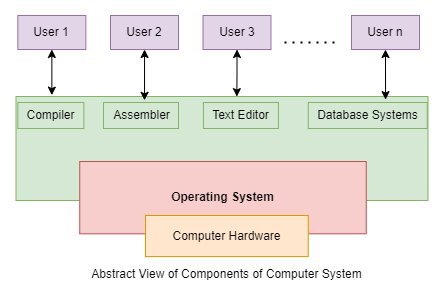OS 1.01 - Operating Systems Introduction
An Operating System (OS) is software that manages computer hardware and serves as an intermediary between the user and the computer hardware. Its primary purpose is to provide an environment in which users can execute programs efficiently and conveniently.
Chapter 1 : Introduction
An Operating System is a software that manages a computer’s hardware and is responsible for allocating resources (CPU, memory, I/O devices, storage) to various programs. It acts as an intermediary between the user and the hardware, aiming to make the user experience both convenient and efficient.
- Mainframe OS: Designed to optimize hardware utilization.
- PC OS: Supports a variety of applications, from games to business tools.
- Mobile OS: Provides an easy-to-use environment for interface with computer and program execution.

1.1 What Operating Systems Do
A computer system consists of the following four components:
- Hardware: Includes the CPU, memory, and I/O devices which provide the system’s basic resources.
- Operating System: Controls the hardware and coordinates its use among different application programs and users.
- Application Programs: Software such as word processors, spreadsheets, and web browsers that help users solve problems by utilizing hardware resources.
- Users: Individuals interacting with the system, running applications, and using the hardware.
The operating system itself does not perform any useful functions; it simply provides an environment where other programs can perform useful work.
1.1.1 User View
Personal Computers (PCs)
A PC is optimized for use by a single person. It prioritizes ease of use and performance, with less concern for resource utilization or how hardware and software resources are shared.
Mainframe/Minicomputers
Mainframes and minicomputers are designed to handle multiple users where resources and information is shared. These systems focus on maximizing resource utilization, ensuring that all resources (CPU, memory, I/O) are used efficiently and that no individual user monopolizes the resources.
Workstations
Workstations are connected to networks of other workstations and servers. They may have dedicated resources while still sharing some with other systems. Their OS strikes a balance between individual usability and resource utilization.
1.1.2 System View
The OS functions as a Resource allocator and is directly involved with the computer hardware.
In multi-user environments (e.g., mainframes), efficient resource allocation is crucial, as the OS must determine how to distribute resources such as CPU time, memory space, file-storage space and I/O devices among programs and users when there are numerous or conflicting requests for resources.
The OS acts as a control program, managing the execution of user programs to prevent errors and ensure proper system use, particularly when managing I/O devices.
1.1.3 Defining Operating Systems
An OS is the core program running on a computer, often referred to as the Kernel. Along with the Kernel, there are system programs and application programs that provide the necessary functions and services to users.
- Kernel: The central part of the OS that manages hardware and system resources.
- System Programs: Additional software that helps in managing and interacting with system hardware and resources.
- Application Programs: Programs used by the end user for specific tasks, such as word processors, web browsers, etc.
In mobile operating systems, the OS includes not only the Kernel but also middleware, which provides additional services to application developers, such as support for databases, multimedia, and graphics. Examples of mobile OS include iOS and Android, both of which integrate Kernel and middleware for comprehensive functionality.
Creation of OS
- Hardware are constructed to solve problems of users.
- Since bare hardware alone is not easy to use, application programs are developed.
- These programs require certain common operations (controlling I/O devices, allocating resources), which are brought together into one piece of software which is the OS.
The OS was developed to provide a user-friendly layer between users and the hardware.
As hardware grew more complex, OS software evolved to manage the increasing variety of resources and user needs.
- Early Uses of Computers: Initially used for tasks like code-breaking, trajectory plotting, and government calculations.
- Moore’s Law: First proposed in 1960, Moore’s Law predicted that the number of transistors on an integrated circuit would double every 18 months, a trend that continues today.